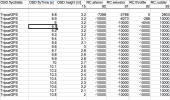Yorkshire_Pud
Well-Known Member
Regarding 1 and a "safe" altitude)Just a follow up reply. I tested the emergency motor cut out and it actually takes a few seconds to activate which is a relief.
in many cases it will ascend to RTH height but it will only ascend to the height you set for RTH. If you are setting that height too high then lower it. But note, when I last tried that when the drone was actually in an RTH the change would not 'take'.
I aim to clear obstacles in an RTH flight path by around 10m. Any greater height is excessive IMO. I change RTH height to suit the location.
Do not trigger RTH as a 'guaranteed cure' for being blown away (see * below). Descending and switching to sports mode is your best bet.
Regarding 2) there is no trigger distance. If the drone's maximum airspeed in any mode is less than the wind speed it can not hold position and that is irrespective of its distance from home.
* In RTH mode the mode has its own nominal speed limit but this can occasionally be increased by giving forward stick. I do not remember if it applies if the drone was, before the RTH, in any mode other than in sports mode but it does apply if the drone was in sports mode when the RTH was activated.










